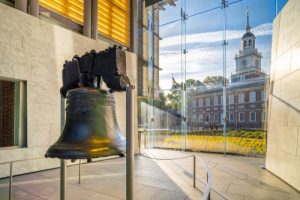Liberty Bell Center
Soon after the relentless Civil War, Americans were eager to search out a symbol of peace and unity. In fact, the American flag actually became one such symbol of unity, while soon after the Liberty Bell became another. In order to help restore the wounds from war, the great and faithful Liberty Bell would then travel across the entire country. When the 1880s arrived, the famous Liberty Bell would then travel to a variety of different cities throughout the country of America proudly stating “Liberty” and inspiring many to join the cause of freedom. 
Forged in 1915, an intricate replica of Liberty Bell was then used to sponsor women’s suffrage. The strong bell traveled the countryside with its mighty clapper chained to its side, completely silent until women from around the country actually won the right to vote. September 25, 1920, Liberty Bell was then brought straight to Independence Hall and proudly rang in different ceremonies in celebration of the ratification of the 19th amendment.
Up to today, oppressed groups around the country will still come over to classic Philadelphia in order to give voice to their historic plight, strongly shouting their call for liberty. November 1751 saw a special letter sent to the Colonial Agent of the Province of the state of Pennsylvania, Mr. Robert Charles, who had been working in London at the time.
Officially signed by Edward Warner, Thomas Leech, and Isaac Norris, the letter represented all the wants and desires of the Assembly to buy a special bell for the State House steeple. The bell of liberty was ordered directly from White chapel Foundry, with precise instructions to etch on it the holy passage from the Book of Leviticus. Thankfully, Liberty Bell was brought safely to Philadelphia in September 1752, but was not officially hung up until March 1753.
After a while, a mysterious break was found on the bell. The actual cause of the break is assumed to have been attributed either to mistakes in its casting or, it being too brittle. As time went on, two Philadelphia workers named John Stow and John Pass were eventually given the damaged bell to be melted down and essentially recast. As they focused on melting down the bell, they would add one ounce and a half of copper to a full pound of the bell of liberty in order to make the new bell less fragile and brittle.
For all their hard labors, they charged somewhat over 36 pounds. Finally, the brand-new bell was happily raised in the old belfry on March 29, of 1753. The outcome was somewhat disappointing, because nobody quite expected the tone of the bell to sound so annoying.
John Pass and John Stow both tried again. Their process was simple: Break up the bell again and recast it. In November, Mr. Norris wrote a letter to Robert Charles stating that he was still unsatisfied with the outcome of the bell and quickly requested that Whitechapel cast yet another new one. Upon the successful arrival of the recast bell, it was quickly agreed that it sounded no better than the Stow and Pass bell.
The Liberty Bell was rung to call the entire Assembly together and to call other people over for a special announcement. The famous Liberty Bell tolled frequently throughout the day. Over the years, the Liberty Bell has truly been an inspiring part of American history and the Civil War. The famous slogan, “Give me liberty or give me death” can make you confident, inspired, and happy about its arrival to where it is today.
THE LIBERTY BELL CENTER TODAY
The beautiful Liberty Bell Center was officially opened to the public in October 2003. From the southern end of the state, the Liberty Bell is visible directly from the street almost the entire day. Once the Fourth of July arrived, around 2 pm Eastern time, kids who are actual descendants of the Declaration signers will symbolically tap the Liberty Bell 13 specific times while bells around the world also ring 13 times in honor of the patriots from the 13 original states. The Liberty Bell Center is a place to find out about the history and past of the Liberty Bell and the people who made it what it is now. Today, the Liberty Bell in Philadelphia, Pennsylvania is a piece of true history that will stand the test of time for years and years to come.

